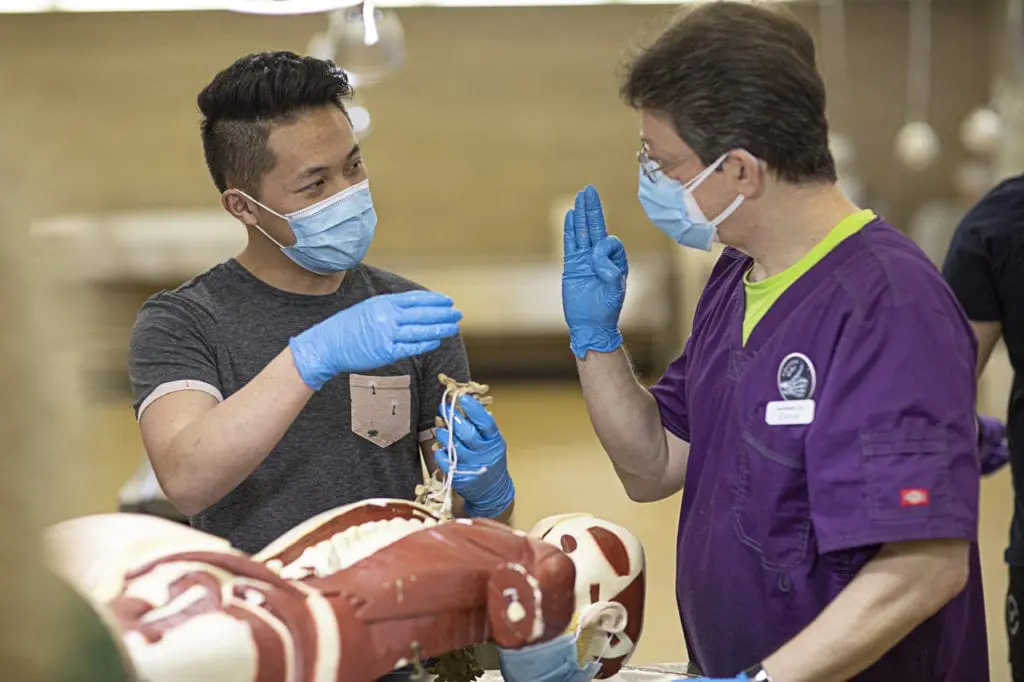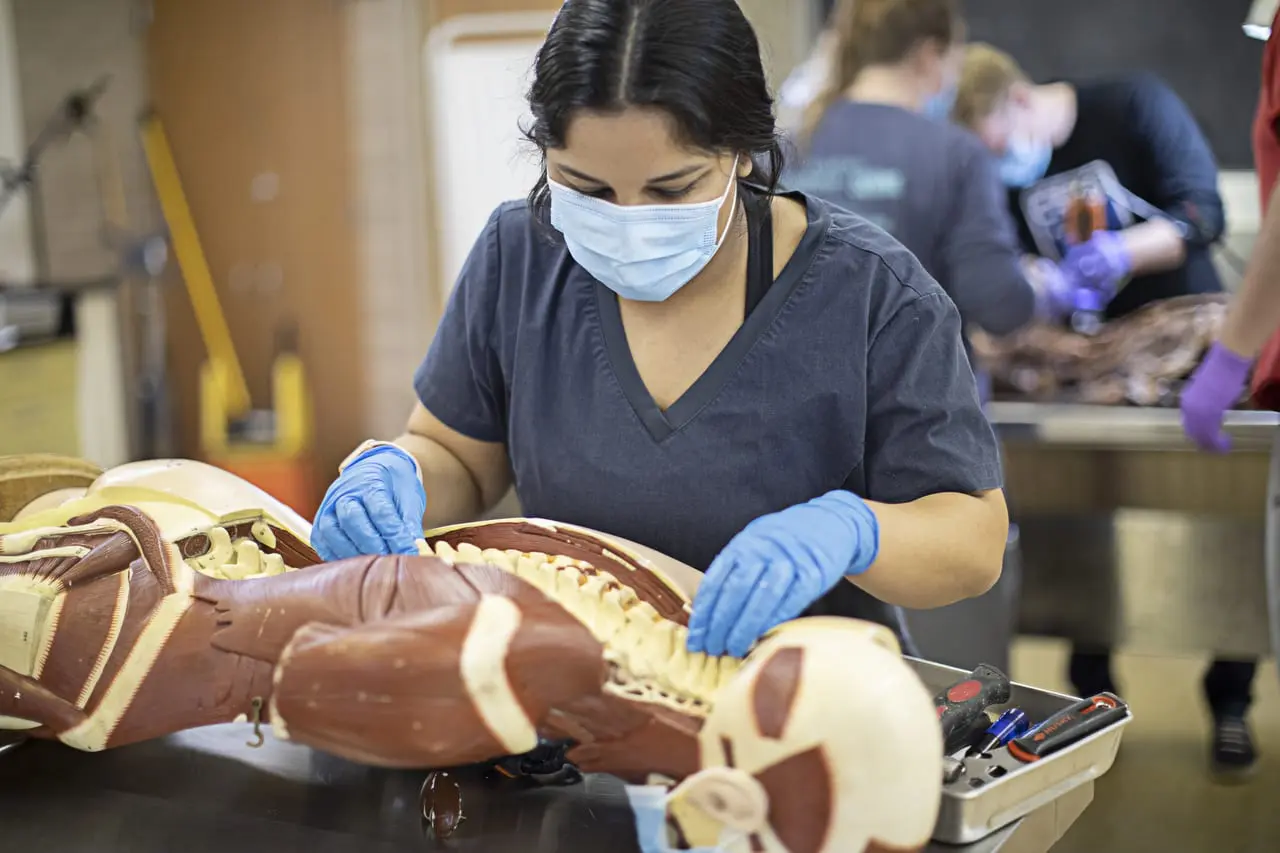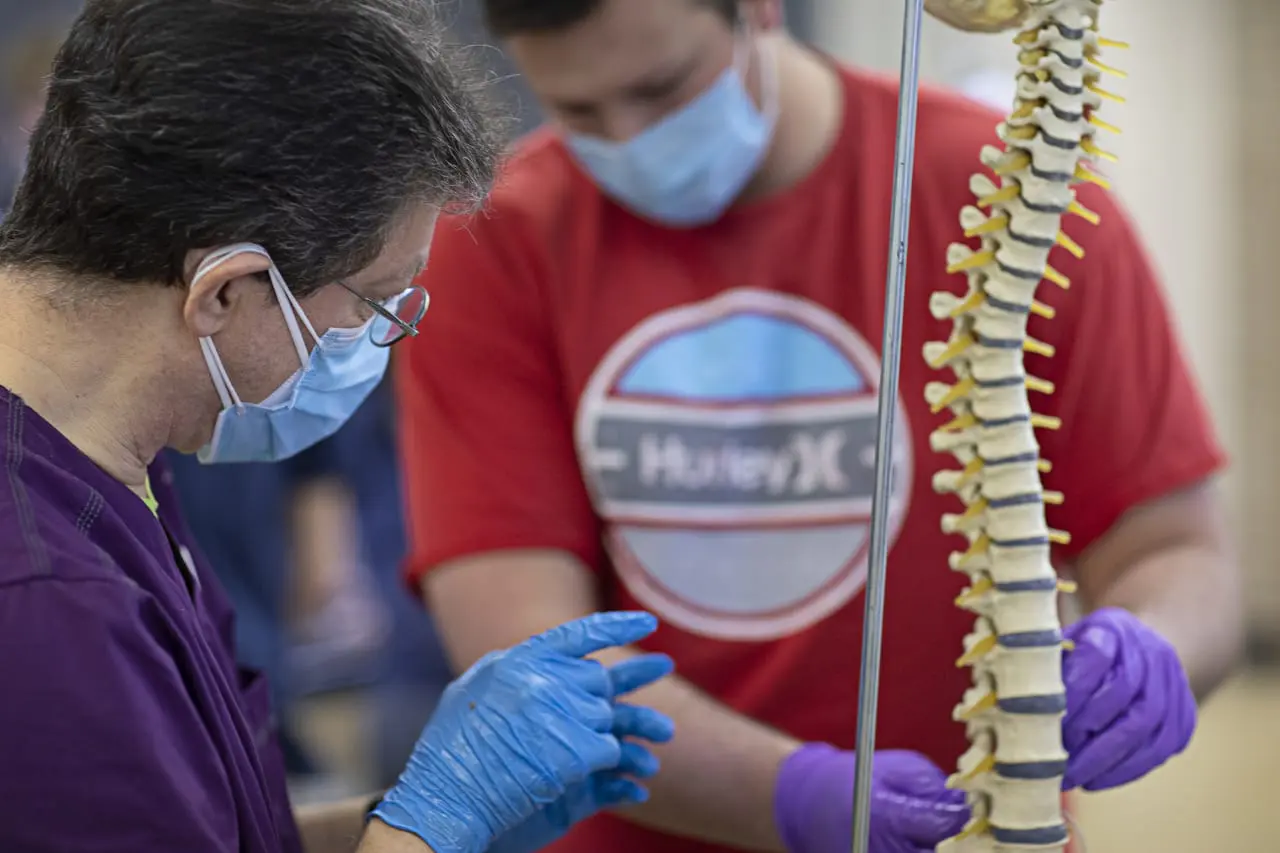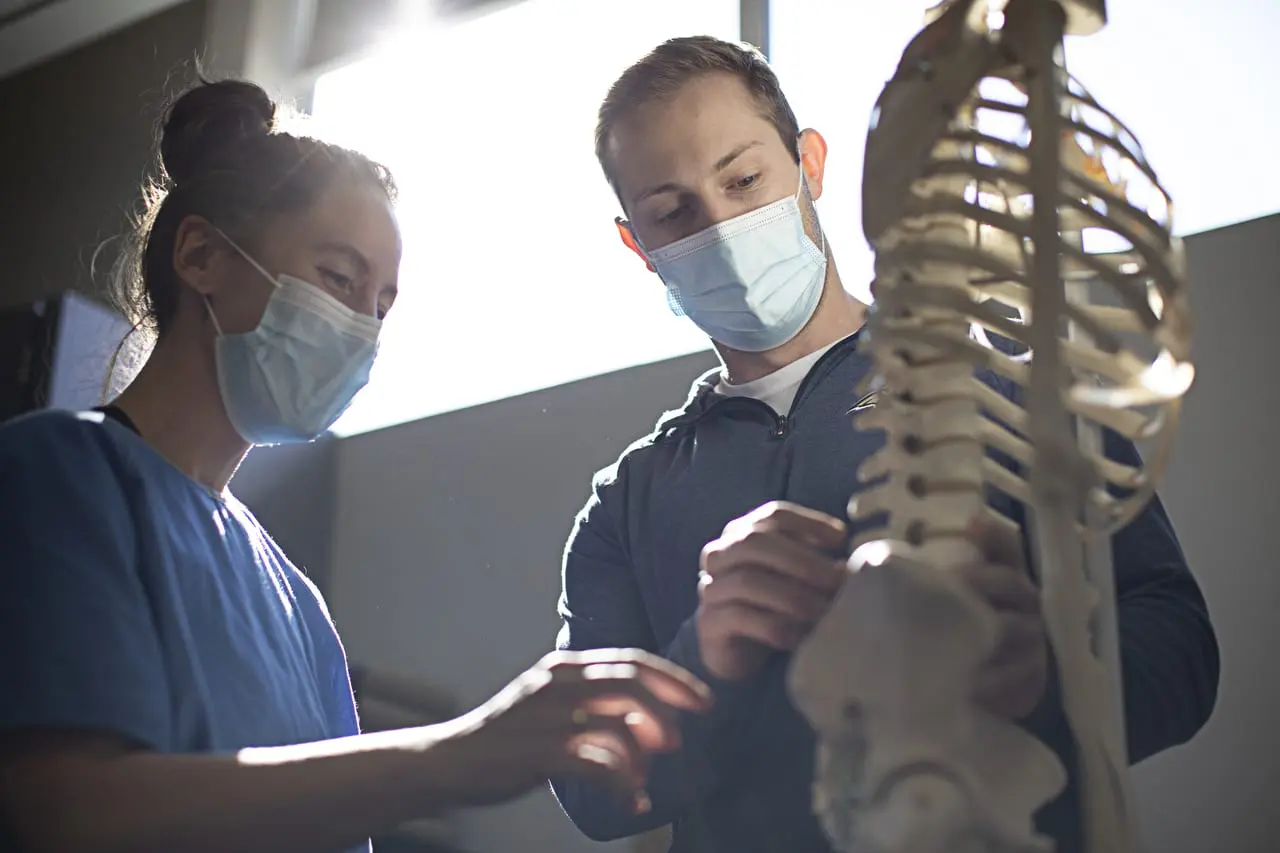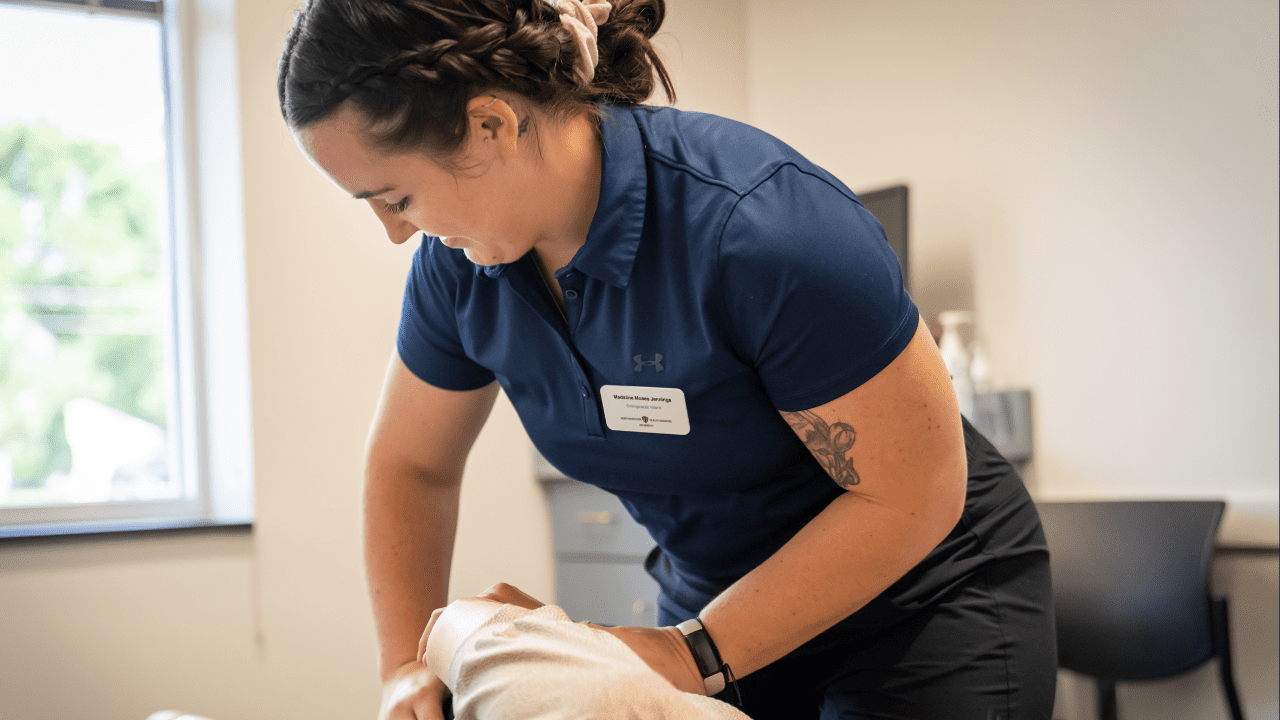How to Become a Chiropractor
Chiropractors play an integral role in improving people’s health and well-being—plus, they’re helping to meet a growing demand for noninvasive treatment options. If you’re considering a career in healthcare, you should know this is an exciting time to join the chiropractic profession. Learn how to become a chiropractor below with this comprehensive overview.
Why do we know so much about becoming a chiropractor? Since our founding in 1941, more than 7,500 chiropractors have graduated from the Northwestern Health Sciences University (NWHSU) chiropractic program.
How long does it take to become a chiropractor?
Becoming a chiropractor first requires at least three years of undergraduate study. You may then be eligible to enroll in a Doctor of Chiropractic degree program, which can take anywhere from three and a half to five years to complete and requires a minimum of 4,200 instructional hours.
You must pass several exams given by the National Board of Chiropractic Examiners. You also need to get a license in the state where you want to practice.
How long is chiropractic school?
Accredited Doctor of Chiropractic degree programs must provide a minimum of 4,200 instructional hours. Some programs extend their curriculum over a longer period of time and can take as many as five years to complete. Others cover more in a shorter period and take significantly less time.
At NWHSU, for example, you can complete your chiropractic degree in three and a half years. Students attend classes year-round, have shorter breaks, and carry a heavier course load.
Note that there are a number of advantages to this. Accelerating your education offers several benefits, including faster completion, which helps reduce student loan debt and allows you to start your professional career sooner. The intense coursework and accelerated pace also better prepare you for the demands of the professional world.
What courses are involved in chiropractic education?
A Doctor of Chiropractic degree program will generally involve three major phases of education: science coursework related to the human body; coursework in clinical and chiropractic sciences; and clinical internships.
- Basic sciences. This involves studying the complexities of the human body and its systems. You will take discipline-specific courses like biochemistry, anatomy, and physiology. Additionally, some programs incorporate hands-on chiropractic techniques early on.
- Clinical and chiropractic sciences. In this phase, you will study physician-patient interaction, physical examinations, etiology (cause) of disease, diagnosis, and treatment. This phase may also include business-focused coursework to prepare you for a professional chiropractic practice.
- Clinical internships. This last major phase moves you fully from theory to practice. As a chiropractic intern, you will be in real-world clinical settings and take on patient cases alongside an experienced chiropractor. Some chiropractic schools have their own clinics. In these clinics, students can intern and work with different types of patients.
For more details on chiropractic education, take a look at the chiropractic school curriculum at NWHSU.
What are the most important chiropractor requirements?
Becoming a chiropractor requires attending chiropractic school, earning a Doctor of Chiropractic degree, passing a series of exams administered by the National Board of Chiropractic Examiners, and securing licensure in the state, province, or relevant jurisdiction where you plan to practice.
Once you gain these chiropractor credentials, you must complete continuing education courses to maintain your licensure. See above for more specifics on chiropractic education.
What should you major in to become a chiropractor?
Chiropractic schools vary in their prerequisites. Choosing an undergraduate major such as human biology, exercise science, or kinesiology can be beneficial if you plan to apply to chiropractic school. These majors require a heavy course load in the sciences and, more specifically, involve studying the human body.
However, it’s not mandatory to select majors similar to the ones recommended above to register for a chiropractic school. At NWHSU, there is an option to complete your bachelor’s degree while in chiropractic school. Our Bachelor of Science in Human Biology Degree Completion program lets you build a path that fits your schedule.
What are the career advantages of being a chiropractor?
Why should I become a chiropractor? A perfectly understandable question, especially if you’re considering other options like a medical doctor or a physical therapist. By becoming a chiropractor, you have an opportunity to do the following:
Help fill the need for primary care health professionals. A growing need for primary healthcare professionals exists. Chiropractic doctors can help by making personalized treatment plans that focus on all parts of health. They emphasize natural methods of care. A chiropractic doctor’s non-invasive services are becoming an accepted primary care approach for pain management.
Join a profession with a bright future
Chiropractic is growing. Experts share a strong job growth is expected in the next ten years. The unemployment rate is very low. Also, according to the American Chiropractic Association, “Chiropractic treatment is a covered benefit in virtually all traditional insurance policies.” More and more, healthcare professionals are referring their patients to chiropractic doctors. This includes medical doctors, physical therapists, and massage therapists.
Enjoy the freedom to create your own career path
The chiropractic profession offers a high degree of autonomy, especially compared to other healthcare professions. Self-employment at a solo practice is a viable and highly popular option for chiropractic graduates.”
There are also numerous other opportunities available, such as working in group practice offices where multiple chiropractors collaborate to provide care. Chiropractors can be part of Integrative clinics, alongside other healthcare professionals like massage therapists and acupuncturists. Other options include primary care clinics, multidisciplinary clinics, hospitals, and VA Medical Centers. Chiropractors can also practice in corporate settings, fitness centers, or sports team facilities, expanding their reach and impact in various healthcare environments.
A chiropractic doctor may choose to specialize in treating specific patient populations. For example, they could focus on underserved communities, pregnant women, children, seniors, or hospital patients. Additionally, some chiropractors may choose to work with amateur or professional athletes, including sports teams, tailoring their care to meet the unique needs of these groups.
Note that you can start preparing to treat specific types of patients while in chiropractic school. For instance, NWHSU offers a Doctor of Chiropractic – Sports Emphasis degree.
Meet the growing demand for non-invasive treatment options
A growing demand exists for healthcare options that don’t involve drugs or surgery. Chiropractors and their non-invasive treatment strategies will play a key role in the evolution of healthcare.
Chiropractors maintain that the human body possesses an inherent ability to heal itself. By using treatment methods that don’t involve surgery or pharmaceuticals, chiropractors can restore or rehabilitate certain body functions and even prevent further disability.
Be part of the whole-person healthcare movement
Chiropractors take the whole body into consideration when they diagnose and treat patients. In fact, more people are seeing the benefits of whole-person healthcare. This is causing a rising demand for chiropractors.
They focus on how musculoskeletal structures, body function, and the nervous system are closely interrelated. They also know how problems in one area of the body can affect other parts. This can affect a person’s overall health and well-being.
Find exciting opportunities in integrative healthcare
Integrative healthcare is a growing patient-focused approach that bridges disciplines such as chiropractic with the kind of mainstream medicine typically practiced in hospitals and primary care clinics.
Healthcare professionals like chiropractors will play an increasingly integral role in delivering healthcare. This movement in healthcare is also creating more opportunities for chiropractors to open integrative healthcare clinics.
Help patients achieve better overall health and wellness
Chiropractors have the knowledge and training to provide health and wellness assessments and can make recommendations on diet, exercise, and other factors that can improve a patient’s health and well-being. This is especially important as more and more people proactively seek ways to live a healthier life. Many chiropractors are choosing to add health coaching and functional nutrition services to their clinics and practices.
Acquire a deep understanding of how the body works
Are you fascinated by the human body? Would you like to gain a deep understanding of it? Compared to medical or physical therapy students, chiropractic students receive more training in anatomy, physiology, diagnosis, x-ray, and orthopedics.
What are key questions to ask when looking at chiropractic programs?
If you’re thinking about chiropractic school, you’ll want to weigh a number of factors. Here are nine critical questions to ask as you explore your chiropractic program options.
1. How will the program’s clinical opportunities provide experience to be successful when you graduate?
Look for a program that provides you the opportunity to work alongside licensed chiropractic doctors—both observing them and assisting them. You should then be allowed to treat patients by yourself, all the while having experienced chiropractors as your mentors. As you look at chiropractic schools, remember that those with community-based internship programs help students gain more experience. This includes working with different chiropractic techniques and various types of patients.
At NWHSU we realize that clinical internships have the potential to shape your interests, your career, and your life. We have a large network of over 150 healthcare connections in the Twin Cities Metro Area and beyond. We help students find great internships. NWHSU also has multiple clinics of our own, both on and off campus, that serve the public. These enable our chiropractic students to conveniently work with practicing clinicians and gain hands-on experience with real patients.
2. How does the program rank nationally in Chiropractic Board Scores?
You want a program that thoroughly prepares students to navigate the National Board of Chiropractic Examiners (NBCE) and earn their licensing process.
Check to see where the school ranks on average NBCE board scores. This is one important reflection of a program’s effectiveness. The culture of a chiropractic program should help instill students with a solid foundation of knowledge and understanding so that they are well-prepared for board exams—and a chiropractic career.
Faculty will also play a large role in providing personalized help with a student needs it.
3. Does the program have features like dual degree options and specialized areas of focus?
You can work in many different settings. You can also specialize in certain treatments and focus on specific groups of patients. A program that offers specialties and dual degree options can help you customize your chiropractic education. This can prepare you for the right career path.
For instance, Northwestern Health Sciences University offers many options for students to incorporate additional specialties to their education. NWHSU has a widely respected Sports Emphasis chiropractic degree that prepares students to treat athletes. Another option is to enroll in our Graduate Certificate in Functional Sports and Performance Nutrition program so you can add functional nutrition to your practice. Plus, we provide a degree completion option for a Bachelor of Science in Human Biology that you can take concurrently with the Doctor of Chiropractic program.
4. How well will the program prepare you for the future of healthcare?
Healthcare as we know it is changing in exciting ways. Make sure you investigate how effectively a given program will prepare you for the future. For example, will you be ready for an integrative approach to healthcare?
To illustrate how an educational environment can prepare you, consider NWHSU. Our model of integrative healthcare creates a space for teamwork and new ideas. It focuses on the health and well-being of every patient.
5. What is the school’s chiropractic philosophy and why does this matter?
Chiropractic schools share clear similarities, as their main objective is to prepare students for the chiropractic profession. However, they can also differ in significant ways. As you explore a potential school, it’s important to understand its teaching methods and its approach to chiropractic care.
One way to do this is by considering questions such as how the school views the role of a chiropractor in a person’s overall healthcare, how strongly it emphasizes scientific principles, and how much importance it places on evidence-based methods within its program.
At NWHSU, for example, we focus on science and seek evidence to support the way we treat our patients. We do not promote any one specific chiropractic philosophy. Rather, we foster critical thinking and intellectual honesty. We also strive to evolve in ways that ultimately provide improved chiropractic care to patients.
While we honor our rich chiropractic history, we do not let it define us. Instead, we strive to create an environment for academic debate and exploration of ideas.
6. Is NWHSU an Accredited Chiropractic School?
You’ll want to attend a school that meets official standards established within the chiropractic profession. Be sure the school you choose is accredited by the Council on Chiropractic Education.
7. What’s NWHSU like?
The best way to find out what a chiropractic school is like is by visiting. If it’s not possible to attend in person, check out the program’s virtual events. Similarly, to get a feel for the campus and the life of a student, you can schedule a virtual visit. You may also want to speak with current students to see how accessible and responsive instructors and other faculty are to answer questions and provide extra support to help you succeed.
8. Where is the NWHSU campus located?
Think through the implications of the school’s location. Northwestern Health Sciences University is located in Bloomington, Minnesota, affectionately known as the Twin Cities. The Twin Cities Metro is a progressive healthcare innovation hub within a state that includes healthcare industry leaders such as Mayo Clinic and Medtronic. Recently, Minnesota was ranked the No. 1 Best State for Health Care. This is due to the state’s great healthcare system and the healthy lifestyle of its residents.
NWHSU has cultivated partnerships with institutions in the region, giving students more opportunities to make connections, gain valuable experience, and plan their future. And don’t forget to research the location in terms of overall lifestyle. Remember, you’ll be spending several years in the area.
The Twin Cities area is often one of the top ten best places to live in the U.S. It offers a big city experience when it comes to restaurants, professional sports teams, and arts and entertainment. Yet it also creates a community feeling through its unique neighborhoods, beautiful lakeside parks, and hundreds of miles of biking and walking trails.
9. How much does earning your Doctor of Chiropractic cost?
This question should include not just tuition and fees. It should also cover all other costs of attending school like whether you will be relocating. Knowing the cost of rent and cost of living will be helpful in determining additional costs. Also, a chiropractic program should be as transparent as possible as it clearly lays out just how much it will cost to attend.
Make sure you incorporate financial concerns into your search early on. The best place to start is with a school’s financial aid specialists. And be sure to also research both school-sponsored scholarships and external scholarships.
Your next step: request more information!
Exploring the possibility of a chiropractic career is an exciting time! You’ve just absorbed a lot of information on how to become a chiropractor. NWHSU has many resources to help you sort out what to expect when attending chiropractic school and how to apply. Our admissions team is a great and knowledgeable place to start.
Published in May 2021. Updated May 2024.
